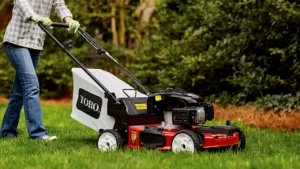If you’re looking to liven up your kitchen and bring a touch of nature indoors, here are 25 ideas for kitchen plants that can thrive in your space. From herbs you can use in cooking to lovely greens that brighten up your countertops, these plants will add some zest and charm to your culinary haven. Let’s dive in and discover some lovely options to get your kitchen blooming!
Edible Flowers for Garnishing
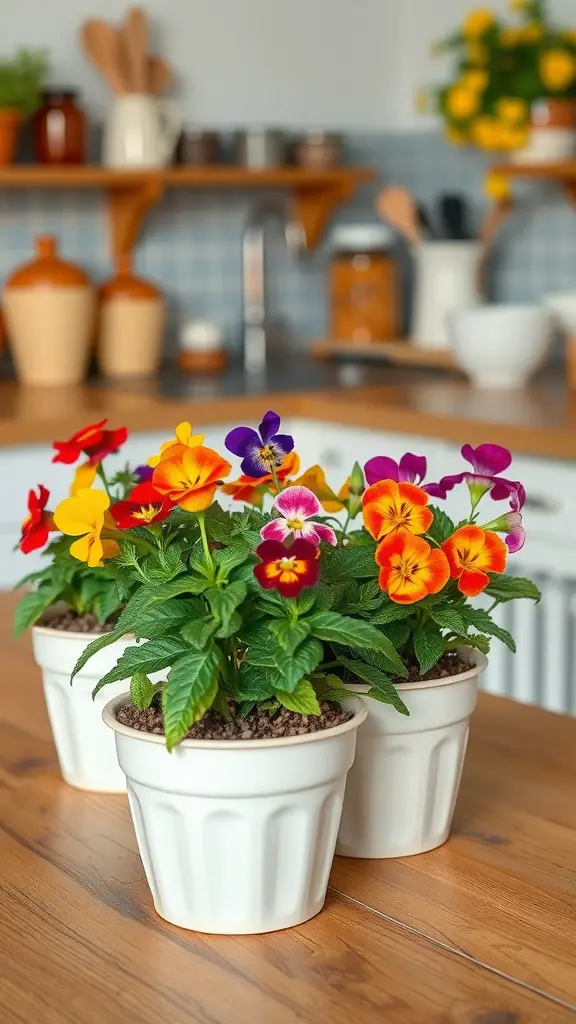
Bringing a splash of color and flavor into your meals is easier with edible flowers like those seen in the image. These beauties can brighten up any dish and add a delightful twist.
The vibrant pansies in white pots are not just pretty; they’re also edible! Pansies have a mild, slightly sweet taste, making them perfect for salads, desserts, or as a garnish on savory dishes.
To use them, simply wash the flowers gently and remove the stems. Toss them into salads for a colorful presentation or use them to decorate cakes and pastries. They can even be frozen in ice cubes to add a floral touch to your beverages.
Creating a small indoor garden with these plants not only enhances your kitchen decor but ensures you have fresh garnishes at your fingertips. Imagine serving a dish garnished with these lovely flowers, impressing your family and friends!
Easy-to-Grow Indoor Vegetables
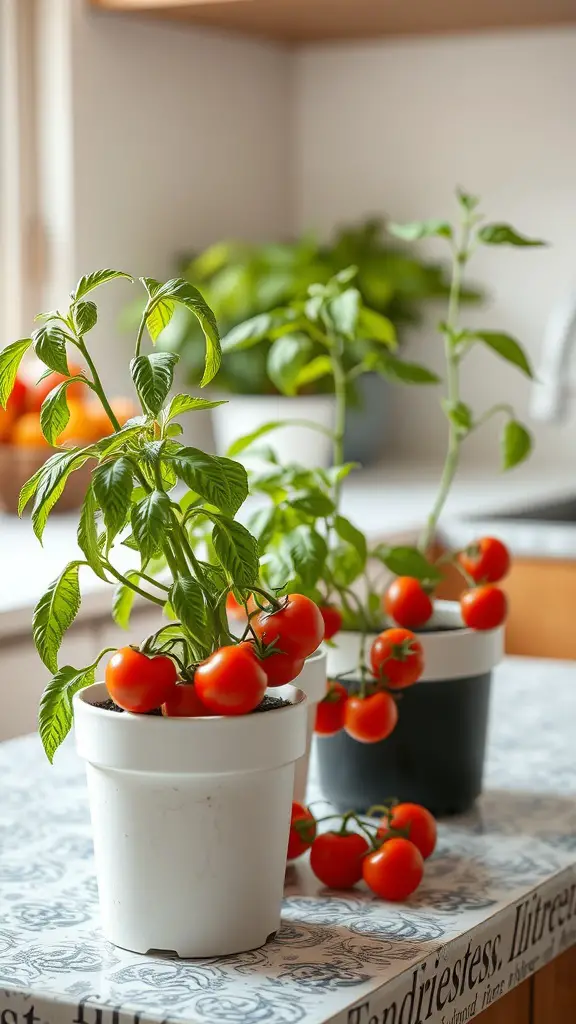
Growing your own food at home can be a rewarding experience, especially when it comes to easy-to-grow indoor vegetables. The image showcases vibrant tomato plants in simple pots, ready to bring fresh flavors to your meals.
Tomatoes are a top choice for indoor gardening. They thrive in pots and require minimal space. Just a sunny windowsill will do the trick! These plants not only look appealing but also provide delicious, juicy tomatoes that can enhance a variety of dishes.
To grow tomatoes indoors, all you need is potting soil, seeds or seedlings, and consistent watering. Position the pots where they can soak up plenty of sunlight, ideally around six to eight hours a day. Regularly check the soil moisture to keep your plants healthy and thriving.
Imagine snipping off a ripe tomato and tossing it in a salad or using it in your favorite pasta sauce. Homegrown veggies add a personal touch to your cooking and can be a fun project for your kitchen!
Herbal Tea Garden

Creating a herbal tea garden is a delightful way to enjoy fresh flavors right from your kitchen. Imagine stepping into your kitchen and picking your own herbs for a soothing cup of tea. In the image, you can see beautiful pots filled with vibrant plants, like chamomile and mint, patiently waiting to be harvested.
To get started on your own herbal tea garden, consider planting easy-to-grow herbs. Chamomile is a popular choice, known for its calming properties. Mint adds a refreshing twist, while lemon balm brings a zesty note to your brews.
Growing these herbs requires minimal effort. Just place them in well-drained pots with good quality soil, and make sure they get enough sunlight. Water them regularly but avoid overwatering, as this can lead to root rot.
Once your herbs are ready, you can blend them for unique tea flavors. Simply steep fresh leaves in hot water for a few minutes. Add honey or lemon for a personal touch. Enjoying your homemade herbal tea will not only be satisfying but also a great way to unwind after a long day.
Indoor Berries for Sweet Treats

Bringing the joy of fresh berries indoors is a delightful way to enhance your kitchen. Imagine a lively strawberry plant, bursting with juicy red fruit, sitting on your countertop. This charming plant not only adds a pop of color but also serves as a tasty treat right at your fingertips.
Growing strawberries indoors is easier than you might think. Choose a sunny spot with at least six hours of light daily. A simple pot with good drainage can do wonders. Regular watering is essential, but be careful not to overdo it. The goal is to keep the soil moist, not soggy.
As the strawberries ripen, you’ll have an excellent opportunity to enjoy them fresh. You can add them to salads, desserts, or simply eat them as a sweet snack. Imagine making a quick strawberry shortcake or blending them into a refreshing smoothie. With your indoor berry plant, sweet treats are just a step away!
Herbs for Flavorful Cooking

Having fresh herbs in your kitchen can truly enhance your cooking experience. The image shows a delightful collection of herbs thriving by a sunny window, just waiting to be used in your next dish. From basil to rosemary, each plant adds its unique flavor to your meals.
Start with basil, known for its sweet and slightly peppery taste. It’s perfect for pasta sauces, salads, and even pesto. Simply snip off a few leaves and add them fresh to your dishes for an extra burst of flavor.
Next up is rosemary, which has a distinct earthy aroma. It pairs beautifully with roasted meats and veggies. Try making roasted potatoes with rosemary: just toss cut potatoes in olive oil, sprinkle with salt, and add chopped rosemary before baking.
Another great herb to consider is thyme. Its subtle flavor enhances soups and stews. A quick tip: add thyme to your chicken stock for a deeper flavor profile.
These herbs not only make your meals tastier but also look lovely in pots. Having them on your windowsill means you can grab a handful whenever you need them. Start your own mini herb garden and enjoy the freshness they bring to your kitchen.
Nutrient-Rich Microgreens

Microgreens are tiny, flavorful plants that pack a punch when it comes to nutrition. They are young seedlings of edible vegetables and herbs, typically harvested just after the first true leaves appear. The image shows a vibrant tray of microgreens, lush and full of life, thriving in a well-lit kitchen environment. This not only adds a pop of green to your space but also offers a fresh source of nutrients right at your fingertips.
Growing microgreens is simple and requires minimal space. You can start with seeds like radishes, basil, or arugula. Fill a shallow tray with soil, sprinkle the seeds evenly, and cover lightly. Water gently and place them in a sunny spot. Within a week or two, you’ll have fresh greens to add to your meals.
These little greens are versatile and can enhance salads, sandwiches, and even smoothies. Their flavor can vary from mild to spicy, depending on the type you choose. Plus, they are an excellent way to boost your vitamin intake without much effort. So why not add this easy gardening option to your kitchen routine?
Succulent and Cactus Collection
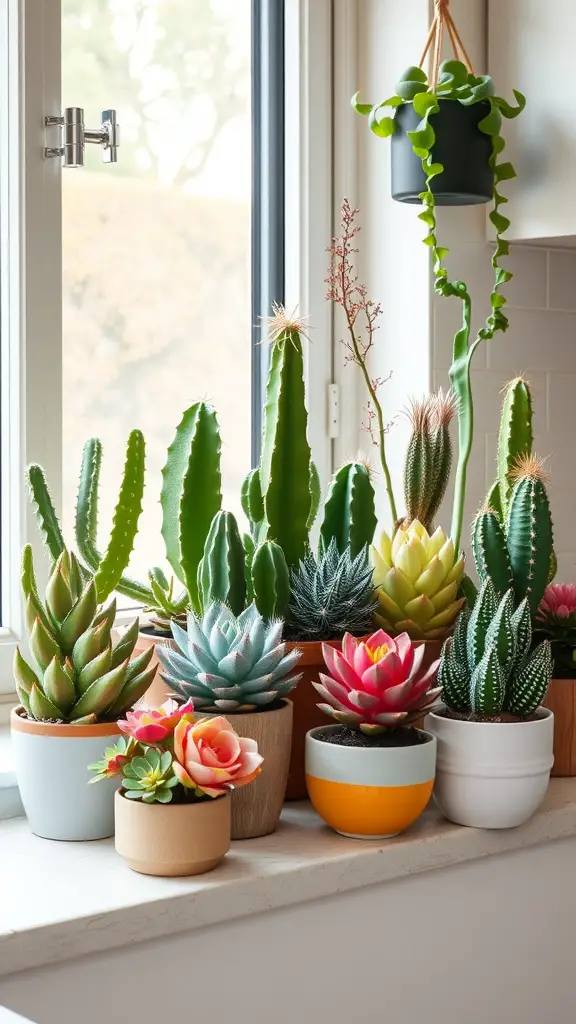
A succulent and cactus collection can bring a lively touch to your kitchen. These plants are not only visually appealing, but they also require minimal care, making them ideal for busy kitchens.
In the image, you can see a variety of succulents and cacti arranged on a windowsill, soaking up natural light. The different shapes and colors create a vibrant display. Some plants are in charming pots, adding to the overall decor of the space.
Succulents, like those in the collection, store water in their leaves, making them drought-resistant. This means you can enjoy their beauty without worrying about daily watering. Cacti, with their unique spines and textures, offer a playful contrast to the softer leaves of succulents.
Consider mixing different types in your own kitchen. You can choose colorful pots to match your kitchen theme. Hanging plants, like the one seen in the image, can also add vertical interest, maximizing your space.
Overall, a succulent and cactus collection not only enhances your kitchen’s aesthetic but also improves the air quality, making it a delightful addition for any home chef.
Spicy Chili Pepper Plants

Chili pepper plants are a fantastic option for your kitchen garden. Not only do they add a dash of spice to your dishes, but they also provide a vibrant splash of color. The image shows a beautiful cluster of red chili peppers hanging elegantly by the window, ready to be harvested. This setup brings a lively touch to your kitchen, making cooking more enjoyable.
Growing chili peppers is relatively easy, and they thrive in warm, sunny spots. If you have a windowsill that gets plenty of sunlight, that’s a perfect place to start. Just remember to water them regularly but avoid overwatering, as they prefer well-drained soil.
When it comes to using these peppers, the possibilities are endless. You can toss them in salads, add them to sauces, or even create your own spicy salsa. Imagine making a fresh salsa with tomatoes, onions, and those delightful peppers straight from your kitchen. Just chop everything up, mix in a bit of lime juice, and you’re ready to go. It’s a simple recipe that brings a lot of flavor.
Compact Fruit Trees
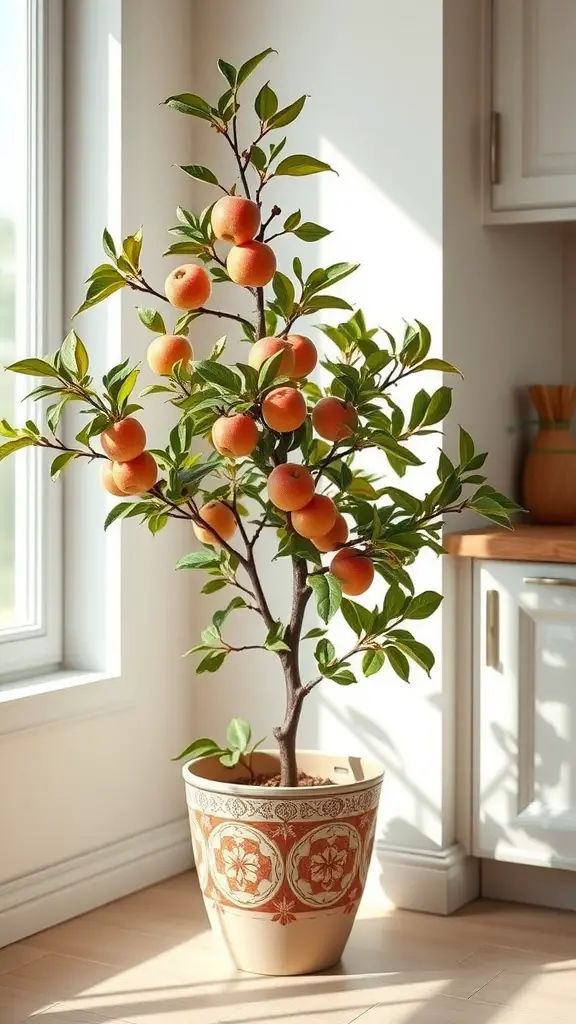
Imagine having a fruit tree right in your kitchen! Compact fruit trees are perfect for small spaces and add a touch of nature indoors. They can thrive in pots, making them ideal for apartments or homes with limited outdoor areas. In the image, you can see a lovely fruit tree filled with vibrant, ripe fruit, bringing life and color to the kitchen. These trees not only look beautiful, but they can also provide fresh fruit for your recipes. Caring for them is quite simple, and they often need just a bit of sunlight and water. They can be a fun project for anyone interested in gardening while enjoying homegrown fruit. Some popular options include dwarf varieties of citrus trees, like lemon or orange, which can flourish in containers and give you delicious fruits all year round. Plus, they add a delightful scent to your home!
Air-Purifying Houseplants
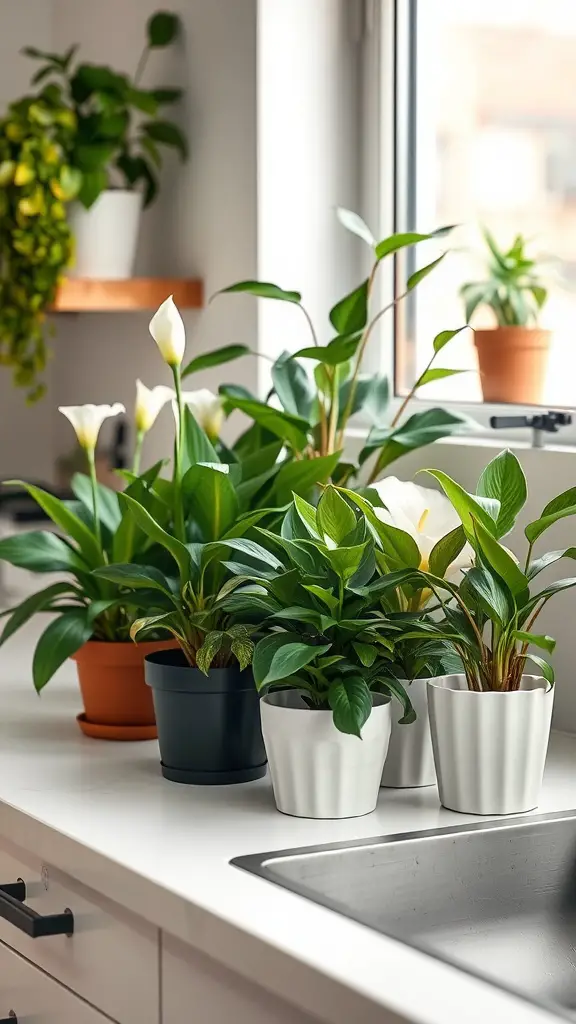
Bringing plants into your kitchen not only adds beauty but also helps improve air quality. The image shows an array of lush houseplants on a countertop, each one chosen for its air-purifying abilities. These plants perform a vital role by filtering the air and absorbing toxins, making your kitchen a healthier space.
Among the plants, you might spot peace lilies and other leafy varieties. Peace lilies are known for their ability to remove harmful pollutants like formaldehyde and benzene. They are easy to care for, requiring only moderate light and occasional watering.
Besides peace lilies, consider adding spider plants or pothos to your collection. Spider plants are robust and can thrive in various conditions, while pothos are celebrated for their trailing vines and adaptability. Both are excellent at purifying the air and can help reduce indoor allergens.
Incorporating these houseplants not only enhances the aesthetics of your kitchen but also supports a healthier living environment. So, whether you’re cooking up a storm or enjoying a quiet cup of tea, you can breathe easier with these green companions around.
Kitchen-Friendly Vine Plants

Vine plants can add a lively touch to your kitchen. They hang gracefully and can transform even the simplest spaces into warm, inviting areas. In the image, you see a beautiful trailing plant in a terracotta pot, suspended by rope. It’s a perfect choice for kitchens.
These plants not only look good but are also easy to care for. They thrive in indirect sunlight, making them ideal for hanging near windows. Just make sure to water them when the soil feels dry. Keeping them in your kitchen can also help purify the air, which is a nice bonus!
Consider adding a few different types of vine plants. Pothos, for example, is known for its heart-shaped leaves and vibrant green color. It pairs well with other kitchen plants, creating a lovely, green backdrop. With the right care, these plants can grow long and trailing, giving your kitchen a cozy, homey feel.
Herb Planters for Small Spaces
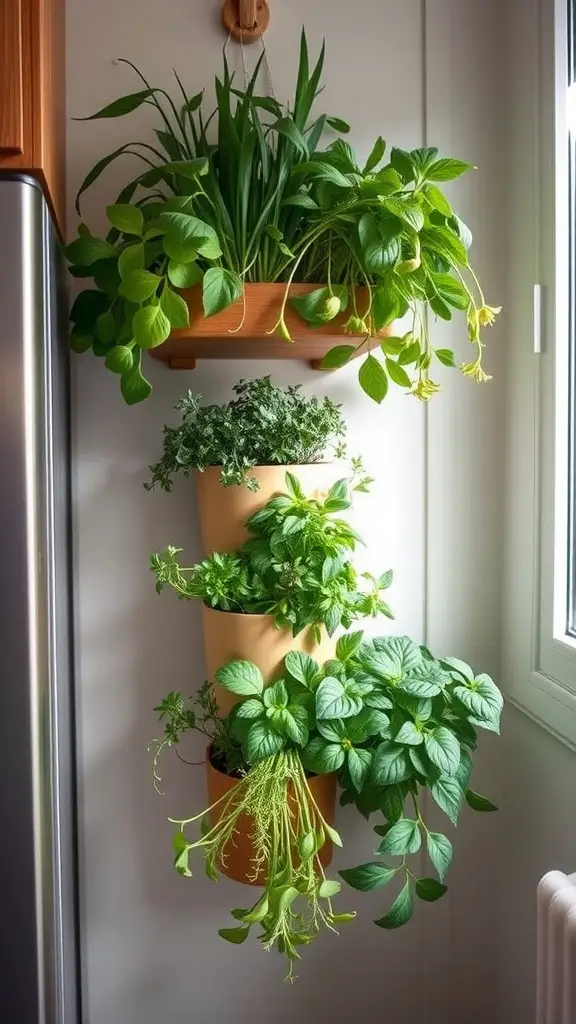
Finding ways to bring greenery into your kitchen can be a fun challenge, especially if you’re working with limited space. The image here showcases a vertical herb planter that makes the most of every inch. This design allows you to grow multiple herbs without taking up much room.
The planters are stacked vertically, featuring a variety of herbs like mint, thyme, and possibly some leafy greens. This setup not only saves space but also adds a splash of color and freshness to your kitchen. Each tier is filled with lush plants, demonstrating how easy it is to incorporate herbs into even the smallest of areas.
Using vertical planters is a smart choice for those who love cooking with fresh ingredients. You can easily snip off what you need for your dishes without a trip to the store. Plus, having herbs on hand encourages you to experiment with new recipes!
When setting up your herb planters, consider which herbs you use most often. Basil, parsley, and cilantro are popular choices that thrive indoors. Be sure to place your planters near a window to ensure they receive enough sunlight. A simple watering routine will keep them healthy and vibrant.
Overall, these vertical herb planters not only maximize your space but also bring a touch of nature into your kitchen, making your cooking experience even more enjoyable.
Unique Foliage Plants

When it comes to adding character to your kitchen, unique foliage plants are a fun way to go. The image showcases a variety of lush green plants that not only brighten up the space but also enhance the overall vibe of your cooking area.
Each plant in the image has its own personality. For example, the large, broad leaves of the plants create a sense of tropical paradise right in your kitchen. They are perfect for anyone looking to bring a bit of nature indoors. Plus, they help purify the air, making your kitchen fresh and inviting.
Smaller plants like the pothos add a touch of playfulness, while the taller plants provide a striking backdrop. These combinations create depth and interest. You can easily mix and match various pots to find the right aesthetic for your kitchen. Using terracotta pots gives a rustic feel, while white ceramic adds a modern touch.
Remember, caring for these plants is straightforward. Most of them thrive in indirect sunlight and need watering every couple of weeks. This makes them ideal for busy kitchens. So go ahead, explore unique foliage plants to make your kitchen feel more alive!
Growing Fresh Garlic Indoors

Imagine having fresh garlic right at your fingertips. Growing garlic indoors is not only simple but also a fun way to add flavor to your meals. The image shows a pot filled with garlic cloves, sprouting green shoots, sitting on a bright kitchen countertop. This setup is perfect for any kitchen enthusiast.
To start growing garlic indoors, all you need are a few garlic bulbs. Choose organic bulbs if possible, as they tend to sprout better. Break apart the cloves, leaving the skins on. Plant them in a pot with good drainage, about two inches deep, and water them lightly.
Place the pot in a sunny spot, ideally near a window. Garlic loves light, so make sure it gets plenty of sunshine throughout the day. In a few weeks, you’ll see those green shoots popping up, ready for you to use. You can snip the greens to garnish your dishes or let them grow longer for full garlic bulbs.
Water the plants regularly but avoid overwatering. Garlic prefers to dry out a bit between waterings. If you keep the soil moist but not soggy, your indoor garlic garden will thrive.
Growing fresh garlic indoors not only enhances your cooking but also brightens up your kitchen space. Plus, it’s rewarding to see your effort turn into something delicious!
Aromatic Citrus Trees

Citrus trees bring a refreshing touch to any kitchen. Imagine the vibrant yellow oranges peeking through lush green leaves, all while filling the air with a delightful fragrance. These small trees are not only beautiful to look at but also practical for any cook who loves to use fresh ingredients.
Growing a citrus tree like the one in the image can be a rewarding experience. The sight of bright oranges against the backdrop of white blossoms adds a cheerful vibe to your kitchen. Plus, having a citrus tree means you can easily add a slice of fresh lemon or orange to your dishes and drinks.
To care for your aromatic citrus tree, place it in a sunny spot. Water it regularly, ensuring the soil drains well. Fertilizing during the growing season helps support healthy growth and fruit production. With a bit of patience, you might soon find yourself harvesting juicy oranges right from your kitchen.
